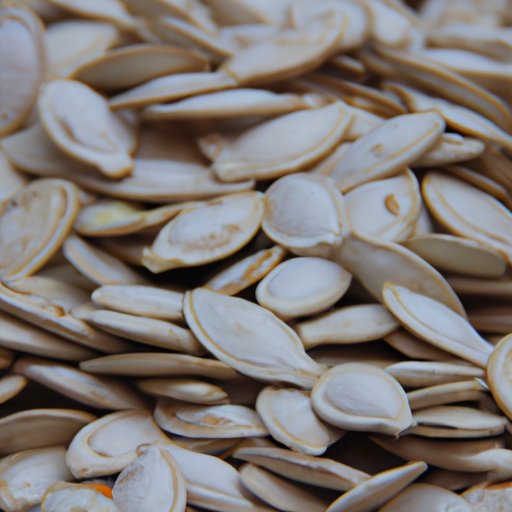
I. Introduction
Pumpkin seeds are a nutritious and delicious snack that have been enjoyed for centuries. With their high fiber, protein, and healthy fat content, they are a great addition to any healthy diet. But can you eat pumpkin seeds in the shell? In this article, we will explore the benefits of eating pumpkin seeds in the shell, debunk common myths and concerns, provide a recipe for roasting pumpkin seeds at home, outline which types of pumpkin seeds can be eaten in the shell, discuss the pros and cons of doing so, and explore the journey of pumpkin seeds from farm to table. This article is for health enthusiasts looking to incorporate more nutrient-dense foods into their diet.
II. Benefits of Eating Pumpkin Seeds in the Shell: A Guide for Health Enthusiasts
Pumpkin seeds are a nutritional powerhouse. They are rich in fiber, protein, and healthy fats like omega-3 fatty acids. They also contain a variety of micronutrients like magnesium, zinc, and potassium. Eating pumpkin seeds in the shell provides additional nutritional benefits because the shells contain fiber and other nutrients that are not present in hulled seeds.
To incorporate more pumpkin seeds into your diet, try adding them to salads, soups, or baked goods. You can also snack on them alone or with other nuts and dried fruits. Just make sure to consume them in moderation as they are high in calories.
III. Unshelling the Truth: Debunking Myths about Eating Pumpkin Seeds in the Shell
Despite the many health benefits of pumpkin seeds in the shell, there are common myths and concerns surrounding their consumption. Some people worry about choking hazards or indigestion. These concerns have been debunked by research, which shows that pumpkin seeds are generally safe to eat in the shell for most people.
Choking hazards are rare, and most people are able to chew and swallow pumpkin seeds in the shell without any problems. Indigestion can occur, but is typically caused by eating too many seeds at once. To avoid digestive issues, start with a small portion and gradually increase your intake over time.
IV. DIY Roasted Pumpkin Seeds: A Delicious Snack You Can Make at Home
Roasting pumpkin seeds at home is a great way to enjoy a healthy and flavorful snack. To make roasted pumpkin seeds, start by removing the seeds from the pumpkin and rinsing them in water to remove any pulp. Then, dry the seeds and toss them with olive oil and any seasonings of your choice. Spread the seeds evenly on a baking sheet and roast in the oven at 350°F for 15-20 minutes, or until golden brown and crispy.
You can season roasted pumpkin seeds with a variety of flavors, such as cinnamon and sugar, garlic and parmesan, or chili powder and lime. The possibilities are endless, so experiment with different combinations until you find your favorite.
V. Pumpkin Seed Varieties: Which Ones Can Be Eaten in the Shell?
There are several varieties of pumpkin seeds available, including hulled seeds and shell-on seeds. Hulled seeds have had the outer shell removed, while shell-on seeds have the shell intact. All types of pumpkin seeds can be eaten, but some may be easier to digest than others.
If you have difficulty digesting the tough outer shell of pumpkin seeds, look for varieties that have thinner shells, like Lady Godiva or Naked Bear seeds. These varieties have softer shells that are easier to chew and digest. Alternatively, you can try hulled pumpkin seeds, which are easier to digest but have slightly less fiber and nutrients.
VI. The Pros and Cons of Eating Pumpkin Seeds in the Shell: What You Need to Know
There are both benefits and drawbacks to eating pumpkin seeds in the shell. On the plus side, eating pumpkin seeds in the shell can be more convenient and less messy than hulled seeds. The shell also adds an extra layer of crunch and flavor to the seeds.
However, some people may have trouble digesting the tough outer shell. This can lead to digestive issues like bloating or stomach upset. To avoid these problems, start with a small portion and gradually increase your intake over time. You can also look for varieties of pumpkin seeds that have thinner shells, or try hulled seeds instead.
VII. From Farm to Table: The Journey of Pumpkin Seeds and Why Eating Them in the Shell is a Great Idea
Pumpkin seeds have been enjoyed for thousands of years and have a rich cultural history. They were originally cultivated by Indigenous peoples in North and Central America, who used them for both food and medicinal purposes. Over time, pumpkin seeds became a popular snack food in many cultures around the world.
Eating pumpkin seeds in the shell can also be a more sustainable and eco-friendly choice. By consuming the entire seed, you are reducing food waste and minimizing your environmental impact.
VIII. Conclusion
In conclusion, eating pumpkin seeds in the shell is a great way to enjoy a healthy and delicious snack. They are packed with nutrients, easy to make at home, and can be enjoyed in a variety of ways. While there are some drawbacks to eating pumpkin seeds in the shell, like potential digestive issues, most people are able to consume them without any problems. If you’re looking to incorporate more pumpkin seeds into your diet, try eating them in the shell for an added nutritional boost.




